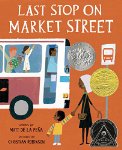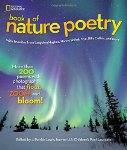
Today's picture book is very special indeed. It won the 2016 Newbery Award, which is very unusual because typically Newbery winners are novels. The story is so universal and powerful that I had to pause after reading it the first time to take in everything. Then I read it again.
Last Stop on Market Street
Matt De La Pena
Illustrated by Christian Robinson
Picture Book
For ages 5 and up
Penguin, 2015, 978-0-399-25774-2
Every Sunday, after church, CJ and his nana get on a bus
and travel across town to Market Street. One Sunday CJ comes out of the church
building and it is raining. He does not feel like going across town in the bus
today. He resents the rain, he resents the fact that he and Nana cannot travel
in a car, he resents the fact that they have to go to the same place after
church every Sunday. In short, CJ is not happy with much of anything at the
moment.
One would think
that Nana would get annoyed by all of CJ’s complaining questions, but she
doesn’t because that is not what Nana is like. Instead, she finds something good
to appreciate in everything that CJ finds annoying. What would happen to the
trees if they did not have rain to water them? If they had a car they would not
get to meet Mr. Dennis the bus driver every Sunday, nor would they see the
interesting characters on the bus. If they did not go to the same place every
Sunday they would get to spend time with “Bobo or the Sunglass Man.”
Then a musician
starts to play on the bus and CJ begins to experience the joy that Nana
understands so well. He begins to understand that sometimes you need to look at
what you do have instead of what you don’t.
This remarkable,
award-winning title explores a simple idea through the eyes of a young child.
Alongside CJ, on that battered bus, and in the dirty streets, we come to
understand that there is beauty everywhere if you know how to look for it.


















